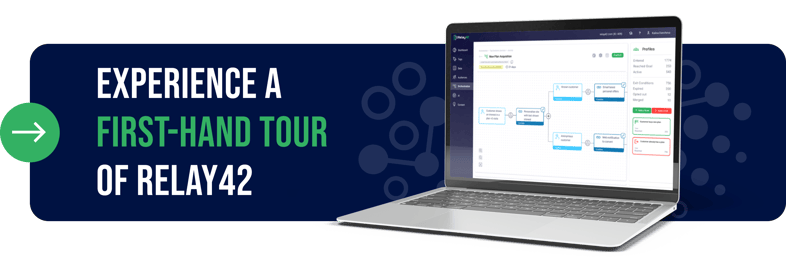How to Be Ready for the Impact of ITP/Cookieless World
by Kalina Dancheva on 15.3.2021

The imminent demise of the third-party cookie is leaving companies no other choice than to learn how to fully leverage their first-party data. The good news is that first-party data is richer, more accurate, and ensures greater protection of consumer privacy.
Still, knowing the value of your customer data, and having the technology and the strategy to shift to a fully first-party data strategy are two very different things, and that’s why we created the Relay42 First-Party Data Program.
Watch the video below with our Customer Marketing Manager and Customer Strategy Consultant to learn more about the program, plus the broader market shift toward first-party data, and how businesses can make the transition.
Rather read? Scroll down to check out the transcript!
Jump straight to specific parts of the interview:
- Why should companies start building their first-party data strategy? (0:42 min)
- Where do companies struggle the most when it comes to building first-party data strategies? (2:50 min)
- The Relay42 First-Party Data Program in nutshell (4:12 min)
- Process & modules of the program (5:19 min)
- Results and customer feedback (7:50 min)
What our customers say about the importance of building a first-party data strategy
"Everyone in digital marketing is now using third-party data and the same platform tools. Therefore, third-party data, although still useful, has become a commodity.
First-party data, however, is a key element to our future success. Being unique to our business, we can use it to recognize customer behavior and make loyalty predictions in our optimization and bidding strategies.
It will increasingly amplify our competitive edge. But even more importantly: with first-party data we have the possibility to be certain that we only use data that our customers trust us to use. And trust is an essential part of the relationship we want to have with our customers."
—Tom Verbugt, Director E-Acquisition - Digital Marketing at KLM Royal Dutch Airlines

Video transcript
Kalina
Hello Richard! Nice to see you, although from a distance as we do these days very often.
I know that you’re super busy, so thank you so much for taking the time for this short chat today.
Richard
Yeah, sure, no problem, glad to be here. Thanks for having me.
Kalina
I have a few questions for you. Are you ready to get started?
Richard
Definitely, let’s do it.
Kalina
Let’s do it!
Kalina
So, we’re sitting here today because we wanted to talk about our new First-Party Data Program. But before we go into the details, I thought that it would be nice to take a step back and ask you: why do you think is it so important that companies start working on their first-party data strategy right now?
Richard
As most people working in digital marketing know for quite some time, there are some major changes happening on the market. Basically, we see that browsers are taking initiatives to cover the privacy of users.
We know it mostly by the term ITP, which is Apple’s initiative to protect user privacy. But we see more and more browsers taking on similar solutions. The change announced by Google that in 2022 they’d also make cookies obsolete, put things in a forward motion.
The impact is still not very clear for everyone. What we see is that there are some major changes in the way we used to do marketing. What you see is that things are limited: the information that Facebook gets via browsers is limited so this makes it harder for Facebook to optimize their algorithm.
There are some limitations that we need to take care of. The good thing is that more and more of these parties are actually covering these topics as well.
So they make it possible to rather than focusing on anonymous data, to focus on first-party identifiers, like email hash, and activate campaigns on those kinds of identifiers.
So, the main reason why we think it's important today to actually start doing it is these major changes and you need to find a way to collect more first-party identifiers and activate those to keep running your marketing campaigns.
Kalina
There's really been a lot going on the market in the past few years when it comes to customer security and privacy, which are all very good developments from a consumer perspective.
As a strategic consultant, you work with marketers from different industries on a daily basis. What do you think is the biggest struggle for companies when it comes to building first-party data strategies?
Richard
I think the most common thing is the unknown. Most people that we speak to don't have a complete understanding of what the actual impact of ITP or cookieless world will be.
The key thing is to make them aware of what's changing. A lot of customers find it hard to see why they should make the shift from third to first-party strategy.
What does this mean for them? How can they collect more identifiers? What kind of legal limitations might they see? How can they overcome these limitations?
Also questions like: "I'm currently doing X with Y as a result, how can I still do that when cookies become obsolete?
So, there are different topics that we see around but the main thing is: What is the actual impact? Making sure that they are aware of the impact is a key thing to start doing.
Kalina
It seems that there are questions flying from different departments within the organizations.
It's really exciting that we now have our own First-Party Data Program to help marketers reach the next level of building their foundation of a first-party data marketing strategy.
In a nutshell, can you tell us what the program is about?
Richard
The First-Party Data Program, or 1PDP as we call it internally, focuses on guiding our clients to move towards a cookieless world.
It's marking sure that they have the right information to completely and fully understand what the impact is for them, provide them with solutions to overcome certain limitations, but also help them with the input to start conversations with different departments like the legal department, different service departments, to help them in this transition.
The program covers a broad set of topics. It's based on conversations we've had with our clients. We start with a readiness assessment and from there, we create a custom action plan.
We look at the client — what is the current situation, what are the topics that they are facing, and how can we help them on those specific topics.
Kalina
And once a customer has started with the program, what does the process look like?
Richard
The process is pretty clear from the beginning. We start with an intake presentation when we actually guide them through what the cookieless world entails; How does it impact you, and what is your need to stay relevant.
The first phase is just to give them an introduction on what’s coming and what are the things that we can do to help them.
After that intake presentation, we offer them a free assessment. The assessment consists of two parts.
First, a dependency scan, which gives them insight into the current situation in the collection and activation of both first- vs third-party identifiers. So, how ready are you when it comes to activating on first-party identifiers?
And the second part of the assessment is the organizational scan.
It focuses more on the business goals, the ambitions, and the current use cases that they are running, and whether or not that's on first or third-party identifiers.
So it gives us a good overview of what they're currently doing, how this relates to their business objectives, and how we can make a shift to first-party data, keeping their business objectives in mind.
It all starts with a scan, or an audit, which will give some results. The results will lead to a good overview of what needs to be done and based on that we'll create a custom action plan.
So within our program, we've created different modules, and per client we select which module we'll be relevant for them. It's a custom-made program after the scan.
So that's what the program entails in a nutshell.
Kalina
I can imagine why it differs per customer as they are in different industries, and have their own ecosystem, challenges, and goals.
It's also really nice to see that a lot of our customers are already quite ahead in their industries.
They've already been gathering first-party data, and we can of course help them reach the next level. That's super exciting.
Finally, I know that the program is its early days, but I was wondering: have you seen already any results, and what has the feedback been so far?
Richard
Definitely. First of all, we see that the program is well received, mainly because it really helps them to understand the actual impact on their situation and what measurements they should take in order to be prepared.
What we also see is that the main outcome is to keep everything running and to find alternatives for third-party identifiers. This is where most of our customers have a hard time.
By guiding them in the way to do this, sharing best practices, coming up with creative solutions, we see that we're capable of helping them move forward.
It's important to share the message and see how we can help our clients.
We see some good results and we get some good feedback as well.
What we hear from our clients is that it takes back the matter into their own hands.
In the past, they were completely relying on third parties, like Facebook collecting their data, and using this data to activate upon.
By going towards first-party data, you have things in your own hands. You can decide what to share with Facebook. You decide what message to share with Facebook, what actions to share with them.
So everything is back in your own hands and that's one of the best results I see for our clients.
Kalina
It's important to mention that it's about creating mutual value first and foremost for the consumers, and of course, and then for brands. So the developments on the marker are actually quite positive for all of us, and we just need to learn how to adapt our strategies and be ready for next year.
Thank you so much, Richard.
If people have some questions, where can they reach out to?
Richard
Thanks, it was a pleasure. Thanks for the discussion.
If there are questions, if you're already a client, you can ask your Consultant or Account Executive and they'll be happy to help you further.
If you're not a client, you can always drop me an email or a LinkedIn message, or fill out the form on our website.
I'm sure that people will find us. Thanks again.
Good luck with the implementation. We'll keep following the developments.
It's really exciting to see the program finally rolling out and see how we can help our customers get ready for 2022.
Thank you.

You May Also Like
These Related Stories

How to Work With Zero, First, Second and Third-Party Data on a CDP

1st-Party Data: The Core of Customer-Centricity


